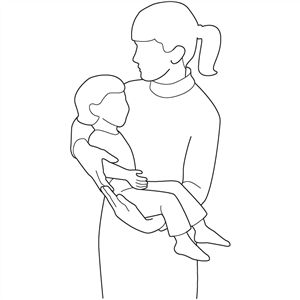Handling the Child with Cerebral Palsy: Difference between revisions
No edit summary |
No edit summary |
||
| Line 11: | Line 11: | ||
=== What is Handling? === | === What is Handling? === | ||
[[File:Handling .png|thumb]] | [[File:Handling .png|thumb]] | ||
Handling is the ability of a person to position, carry/hold, and move a child with cerebral palsy or other neurodevelopmental disability in such a way that his/her body achieves [[Positioning the Child with Cerebral Palsy|postural control]]. Children with cerebral palsy have abnormal muscle tone and movement, resulting in abnormal posture that makes it difficult for them to handle. | Handling is the ability of a person to position, carry/hold, and move a child with cerebral palsy or other neurodevelopmental disability in such a way that his/her body achieves [[Positioning the Child with Cerebral Palsy|postural control]]. Children with cerebral palsy have abnormal muscle tone and movement, resulting in the abnormal posture that makes it difficult for them to handle. | ||
It is necessary for both parents and caregivers, to have knowledge of handling children with cerebral palsy, as they stay with them almost many hours per day. Proper handling will help a child to do more purposeful activities and help the brain learn typical posture. | It is necessary for both parents and caregivers, to have knowledge of handling children with cerebral palsy, as they stay with them almost many hours per day. Proper handling will help a child to do more purposeful activities and help the brain learn typical posture. | ||
== What Happens while handling a Child with Cerebral Palsy? == | |||
Revision as of 15:57, 16 April 2023
This article is currently under development. Please come back soon to see the finished work!![edit | edit source]
Introduction[edit | edit source]
When working with children with cerebral palsy, parents, caregivers, or therapists must be knowledgeable about handling skills. Children with cerebral palsy show atypical movements that restrict the child's ability to develop, and if the child remains in an atypical position for a long time, deformities may occur, which can lead to a permanent disability.
Handling skills are important because they have a positive impact on all interventions for cerebral palsy. Good handling facilitates more purposeful active movements for a child with cerebral palsy.
What is Handling?[edit | edit source]
Handling is the ability of a person to position, carry/hold, and move a child with cerebral palsy or other neurodevelopmental disability in such a way that his/her body achieves postural control. Children with cerebral palsy have abnormal muscle tone and movement, resulting in the abnormal posture that makes it difficult for them to handle.
It is necessary for both parents and caregivers, to have knowledge of handling children with cerebral palsy, as they stay with them almost many hours per day. Proper handling will help a child to do more purposeful activities and help the brain learn typical posture.







